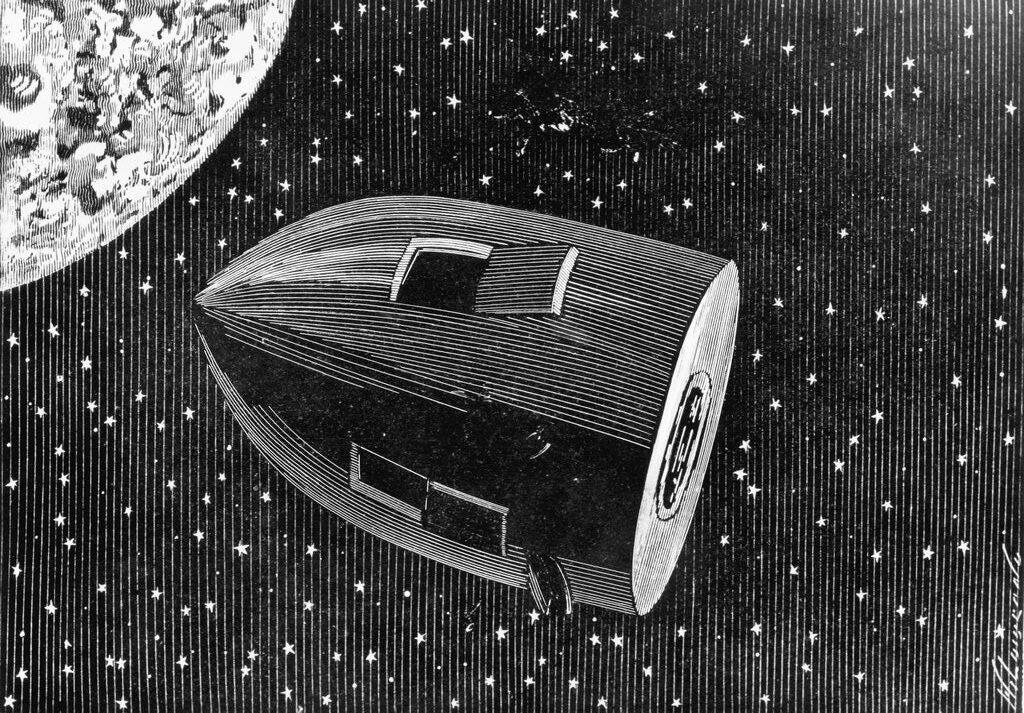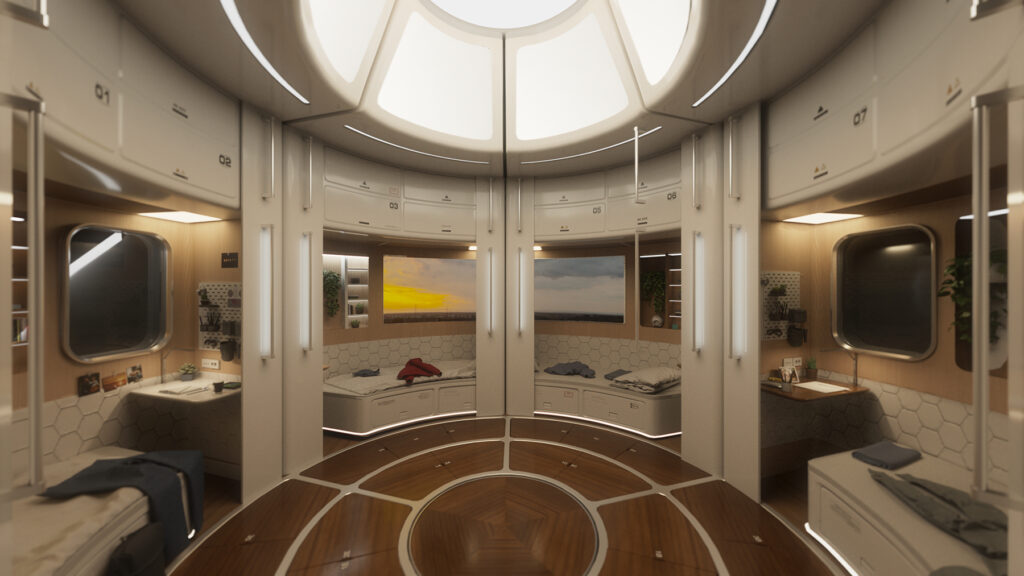Since man could gaze upon the stars, he has been fascinated by them. Space has always seemed like a place of mystery and adventure, and humans have long dreamed of exploring it. The history of space exploration began when astronomers first started to develop theories about the stars, the existence of other planets, and their motions across the sky. In the early 1800s, telescopes were invented that allowed scientists to observe planets and stars in greater detail. Gradually, this led to further discoveries about our solar system and the universe. Eventually, our knowledge of space travel and technical capabilities led to the first space missions.
In 1957, the Soviet Union launched Sputnik 1, the first artificial satellite to orbit the Earth. This event marked the beginning of the Space Age, and over the next decades, many more satellites were sent into orbit. In 1961, the first human traveled to space when Soviet cosmonaut Yuri Gagarin made a single orbit around the Earth. This event gave way to the space race between the USSR and the United States, leading to the first man on the Moon.
Since then, space exploration has continued to evolve, with new technologies and missions being developed continuously. Missions from robotic probes that have left our solar system to robotic rovers currently exploring Mars. More recently we have seen commercial efforts in developing space systems advance and surpass government expectations. The development of Heavy-Lift vehicles, crew transportation, and commercial space stations are all being developed and/or are in operation. Mankind is closer than ever to unlocking the limitless potential of space. The future of space exploration is both exciting and unknown, and we can only speculate on what might be possible but one thing is for certain, space exploration will transform the future in unpredictable ways.
In the 1970s, NASA launched the Hubble Space Telescope, which has been called the most important telescope ever built. Hubble has made many groundbreaking discoveries about the universe, including identifying thousands of new galaxies. In recent years, NASA has launched a number of other space telescopes, including the James Webb Space Telescope and the Transiting Exoplanet Survey Satellite. These telescopes are allowing us to explore space in greater detail than ever before, and they are paving the way for even more advanced missions in the future.

Space Travel in Science Fiction
Throughout history, we have always looked to the stars for inspiration. Many writers have been inspired by the dream of space travel and exploration. One such writer was Jules Verne, a French author who wrote about space exploration in the late 1800s. His novels include “From the Earth to the Moon” and “Around the World in 80 Days”. These books were some of the first to explore the possibilities of space travel and described many of the challenges that would need to be overcome in order to make it happen. Verne’s work inspired generations of scientists and explorers and helped to pave the way for the space age we live in today.
Jules Verne’s novel “From the Earth to the Moon” tells the story of a group of astronauts who travel to the moon. The novel was based on real-world technology of the time, and describes many of the challenges that would need to be overcome in order to make a trip to the moon possible. In his novel he described the three-man spacecraft that was designed by Jules Verne himself. It consisted of a crew compartment, a rocket engine, and a landing module. The crew compartment was cylindrical in shape and housed the astronauts during their trip to the moon with the necessary equipment. The rocket engine provided power for the spacecraft, and the landing module was used to land on the moon’s surface. Jules Verne Moon vehicle was launched from Earth by means of a large rocket called the Columbiad. The Columbiad was powered by gunpowder, and generated enough force to send the spacecraft hurtling into space. The astronauts were seated in reclining chairs inside the crew compartment, and were protected by thick glass windows.
Upon reaching the moon’s orbit, the landing module detached from the crew compartment and descended to the surface of the moon. What is remarkable about Verne’s story was that it predicted with an astonishing level of accuracy what would take place during the Apollo 11 mission. This story inspired humans to imagine a journey beyond Earth’s atmosphere and explore other worlds. Jules Verne’s “From the Earth to the Moon” helped inspire the goal of human space exploration, and remains an important work of science fiction literature today.
The Apollo Program – NASAThe Apollo Program – NASA
First Man
The Apollo program was a historic event that marked the first time humans had ever traveled to the moon. The mission was launched in 1969 and involved a crew of three astronauts: Neil Armstrong, Buzz Aldrin, and Michael Collins. The program was launched in 1961 with the goal of sending humans to the moon. To achieve this, NASA developed a variety of new technologies, including rockets, spacecraft, and astronaut gear. The Apollo rockets were some of the most powerful ever built. They used a combination of fuel and oxidizer to generate thrust, allowing them to reach high speeds and escape Earth’s gravitational pull. The spacecraft were designed to withstand the harsh conditions of space and protect the astronauts inside. They also had navigation systems that allowed them to travel to the moon and back. The astronaut gear was some of the most advanced ever created. It included helmets, suits, and life support systems that allowed the astronauts to survive in space. The gear was also designed to be lightweight and portable, so that it could be easily carried into the spacecraft.
NASA’s Apollo program was a remarkable achievement, and it would not have been possible without the development of many new technologies. The program laid the foundation for future space exploration, and it continues to inspire people all over the world. It was an undertaking of immense proportions, and it required years of preparation and training. The astronauts had to be skilled in both science and engineering, and they also needed to be able to survive in hostile environments. The journey to the moon was a perilous one, and there were many risks involved. But the astronauts were determined to succeed, and they ultimately achieved their goal. On July 20, 1969, Neil Armstrong became the first human to walk on the moon. This was an unforgettable moment in history, and it has been remembered as one of the greatest achievements of mankind.
Current State of Space Exploration
Today, human space exploration is at a turning point. For many years, the only way to travel to space was by using expensive and complicated spacecraft that were owned and operated by governments or large corporations. However, the cost of launching payloads into space has decreased dramatically, thanks to the development of new technologies such as reusable rockets. This has made it possible for private citizens and companies to launch their own spacecraft into orbit, and is opening the doors to a new era of space exploration.
In recent years, there has been a surge in private space activity, with companies such as SpaceX and Blue Origin developing new spacecraft and technologies for space travel. Space X has developed a heavy launch vehicle called the Starship, which will be capable of carrying 100 metric tons to space or as they claim 100 people. While Blue Origin is currently developing the heavy lift vehicle New Glenn is also capable of carrying large payloads to LEO such as space station modules and other systems. These capabilities will be transformational. These companies are working to make space travel more affordable and accessible, which will help to open up space for future generations. Government-run space programs are also ongoing, with agencies such as NASA continuing to explore the universe using telescopes and other planets with robotic rovers. NASA is also supporting a number of ambitious projects, including the launching of the Orion spacecraft developed by Lockheed Martin onboard the Space Launch System. The Orion spacecraft is designed to carry astronauts to lunar orbit and back, while the Space Launch System is a powerful rocket that will be used to send Orion and other payloads into orbit from where they will continue to the Moon.
Overall, human space exploration is progressing rapidly, and there are many exciting things happening in the world of space travel. We are entering a new era of space exploration, and there are many opportunities for people from all walks of life to get involved. So far, we have only scratched the surface of what is possible in terms of space travel, and It is exciting to see the progress being made by commercial space companies in advancing access to space.

The International Space Station (ISS) is a large, multinational spacecraft that has been orbiting the Earth since 1998. The ISS is the largest man-made object in space, and is the result of cooperation between multiple countries including the United States, Russia, Canada, Japan and 11 European countries. Construction began in 1998 and was completed in 2011. The construction of the ISS took many years, and involved the cooperation of multiple countries. The project began in 1998, when the United States, Russia, Canada, Japan and 11 European countries agreed to work together on the development of a large, multinational spacecraft. Construction lasted more than 12 years and was completed in 2011. It has been home to a variety of research facilities that allow astronauts to conduct experiments in microgravity. The ISS has also been used to study the effects of long-duration spaceflight on the human body. It has helped to advance our understanding of spaceflight and the effects of microgravity on the human body. It is hoped that it will continue to serve as a platform for research and experimentation for many years to come.
The ISS is also an important tool for international cooperation, and has helped to build relationships between different nations. The station has been visited by astronauts from over 30 different countries, and has provided a unique opportunity for people from all corners of the world to work together towards a common goal. Overall, the construction of the ISS was a complex undertaking that involved the use of many different technologies. These technologies have helped to advance our understanding of spaceflight, and will be important for future missions into deep space.
There are many different modules that make up the international space station, each with its own unique function. The Russian Zvezda service module is the station’s command center, providing living quarters, control systems, and life support for the crew. The American Destiny laboratory module is used for research into physics, biology, and medicine. The Japanese Experiment Module (Kibo) is the largest module on the space station, and is used for research into earth observation, materials science, biotechnology, and human physiology.
The primary purpose of the station is to provide a platform for international research cooperation in areas such as physics, astronomy, biology, and human endurance. The station has hosted numerous experiments over the years, including studies on microgravity and space radiation. In addition to its research capabilities, the ISS also serves as a valuable training ground for astronauts who are preparing for future missions to deep space. The ISS represents humanity’s ongoing efforts to explore and understand our universe, and it will continue to play an important role in space exploration in years to come. Thanks to its many years of service, it remains one of humanity’s most impressive achievements in spaceflight.
The Challenges of Space Transporation
The cost of space transportation is a major obstacle to developing space architecture. It is very expensive to send anything into space, and the farther away you want to go, the more expensive it becomes. There are also limits on how much weight a spacecraft can carry, so transportation is often limited by what objects can be physically sent into space. This makes it difficult to transport large objects or large numbers of people into space. One way to reduce the cost of space transportation is to develop advanced technologies that require less fuel or that can reuse or recycle materials.
Space Architecture
Space architecture has a long and storied history, dating back to the early days of human space exploration. Space architecture is an interdisciplinary field that draws on the skills and knowledge of a variety of disciplines, including engineering, architecture, and science. It involves the design, engineering, and construction of advanced habitat architecture and its transportation beyond Earth’s atmosphere. It involves establishing a vision, working with systems engineering and integrating subsystems into a human occupiable structure. Many of these systems are unique to space architecture while other elements or drivers can also be found in traditional Architecture. The challenges are most associated with overcoming, mass limitations, extreme environmental conditions and human factors affecting health and wellbeing.
Space architects apply principles of engineering, architecture, and other disciplines to the planning, analysis, and design of space vehicle systems, facilities, and supporting infrastructure. The field of space architecture encompasses a wide range of activities, from the design of spacecraft to the operation of space facilities. The benefits of space architecture include the development of new technologies, the advancement of scientific knowledge, and the exploration of new frontiers. As such, it offers a unique opportunity to develop a broad understanding of the challenges involved in designing and constructing habitation and transportation systems for outer space.
Space architects must consider the needs of astronauts and ensure that living areas are comfortable and functional. Together Space Architects and Systems Engineers are responsible for the design and construction of spacecraft and other space vehicles. They must understand the principles of systems engineering and manufacturing in order to create efficient and reliable systems. Space architects must also consider a variety of human-related factors when designing a space habitat. The most important factor is the safety of the astronauts who will be living in the habitat. Human health and well-being involve balancing the relationships between crew systems, accommodations, lighting, comfort, and environmental systems. It is important that the habitat be both comfortable and functional for the astronauts who will be living in it. They must also ensure that the habitat is properly ventilated and has adequate supplies of air, water, and food.
NASA has a set of standards and requirements that must be met in order to design a space habitat. These standards include safety and security requirements, as well as environmental and operational criteria. The NASA-STD-3001 Space Flight Human-System Standard is a document that outlines the requirements for designing a space habitat. It covers everything from the layout of the habitat to the safety and comfort of the astronauts who will be living there. The standard is based on the principles of engineering and architecture, and it draws on the skills and knowledge of a variety of disciplines. This makes it an invaluable resource for space architects.
Other factors that space architects need to consider include the size and layout of the habitat, the type of materials used in construction, and the level of radiation exposure. Habitats must be designed to accommodate the needs of the astronauts who will be living in them, including their daily routine, work schedule, and recreational activities.
Space architects must constantly innovate in order to overcome the challenges of designing and constructing habitation and transportation systems for outer space. This involves the development of new technologies and the refinement of existing ones. By exploring new frontiers, space architects help to expand our understanding of the universe, and how we can live and thrive beyond earth. By extending human presence into outer space, we are able to gain a better understanding of our place in the universe and the potential for future exploration.
Some of the technologies being developed in space include:
New types of spacecraft propulsion systems are more efficient and require less fuel.
Advanced materials that are stronger and lighter than those currently used in spacecraft construction.
New ways to generate power in space include solar, nuclear, and fusion power.
Software and hardware that can operate in a hostile environment with no oxygen or sunlight.
Robotic systems that can be used for construction, maintenance, and repair tasks.
When most people think of space architecture, they tend to imagine grandiose plans for futuristic cities on other planets. However, the field of space architecture is not limited to science fiction; there are already a number of examples of space architecture that have been designed, engineered, and manufactured on Earth and then sent to Space. In Europe, China, and the United States, there are a number of Habitats that have been designed and built for use in space. These Habitats are used for a variety of purposes, including research, commercial activity, and government policy. In order to build these Habitats, a significant amount of funding is required, as well as a strong Collaboration between different businesses and agencies. The technology used in the construction of Habitats is also constantly evolving, as new advancements are made in the field of space exploration. As a result, Habitats are constantly being improved and updated. However, the most important aspect of space architecture is the people who live and work in these Habitats. Without the dedication and passion of the astronauts, scientists, and engineers who inhabit these structures, they would simply be lifeless shells. It is the people who give Habitats their purpose and make them truly unique places.
There is no doubt that space architecture will play a pivotal role in humanity’s future. As we look to the stars, there are a number of questions that need to be answered. Where will we build our habitats? How will we protect ourselves from the harsh conditions of space? And, perhaps most importantly, how will we ensure that our civilization can thrive in the long term? These are complex challenges, but they are not insurmountable. Low Earth Orbit is an obvious starting point for our future in space. There are a number of companies, such as Blue Origin and SpaceX, who are already working on developing habitats and transportation systems for this region. The Moon is another potential home for humanity, and various government and private entities are already planning missions to establish a permanent presence there. Mars will someday have humans walking on its surface, and it is clear that it will take a concerted effort from the entire world to make it a viable option for long-term habitation. However, it is important to remember that these challenges are not just technical; they are also political and social. In order to create a sustainable future in space, we need to come together as a species and work towards a common goal. Space architecture will be essential in making this happen, and it is clear that it has a bright future ahead.[/vc_column_text][/vc_column][/vc_row]


